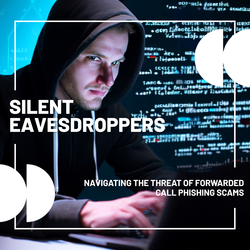Silent Eavesdroppers: Navigating the Threat of Forwarded Call Phishing

In the dynamic realm of cyber threats, Phishing remains a substantial part of the attacker's arsenal. Traditionally, phishing is an email-based scam enticing users into divulging sensitive data by impersonating trustworthy entities. However, attackers are continually enhancing their techniques, bridging our digital and telephonic interactions. In this blog post, we'll unravel a sophisticated phishing variation - "Call Forwarding Phishing" and its close relative, "Vishing," where cybercriminals target not just your emails but your phone calls as well.
Vishing: An Introduction
Before diving into Call Forwarding Phishing, let's first understand the concept of Vishing or voice phishing. In a vishing attack, scammers use telephone services to deceive individuals into providing personal or financial information. Using caller ID Spoofing, scammers can mask their identity or impersonate legitimate organizations, increasing the perceived authenticity of their fraudulent requests.
The Call Forwarding Phishing Scam: A Closer Look
Expanding on the principles of vishing, Call Forwarding Phishing is a nuanced approach where attackers don't just spoof phone numbers - they essentially hijack them. Here's how it unfolds:
- You receive a phishing email masquerading as a legitimate source – your bank, a government agency, a well-known e-commerce website, etc.
- The email includes a phone number almost identical to the organization's actual contact.
- Upon calling this number, you inadvertently dial a forwarding number arranged by the attacker.
- The call then connects to the real customer service line of the impersonated organization, lending a veil of legitimacy to the conversation.
- Meanwhile, as you converse with a genuine representative, the scammer listens in the background, capturing any personal data disclosed.
Guarding Against Vishing and Call Forwarding Phishing
These sophisticated techniques might seem daunting, but awareness and vigilance can shield you from falling prey. Here's how you can protect yourself:
- Never utilize contact details provided in an unsolicited email. Instead, use the contact information from the company's official website or other trusted sources.
- Exercise caution with requests for personal information over the phone, especially when the call originates from an email-provided number.
- If anything seems off, disconnect the call and initiate a new one yourself using verified contact details.
The digital world evolves at a rapid pace, and with it, the stratagems of cyber criminals. By staying informed and adopting proactive safeguards, we can thwart these silent eavesdroppers, ensuring our personal data remains under lock and key. Stay safe, stay aware, and remember – it's better to be overly cautious than regretful when it comes to your personal information.
